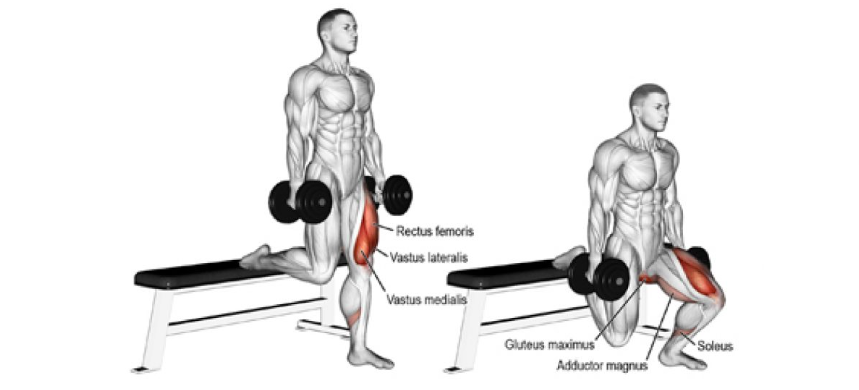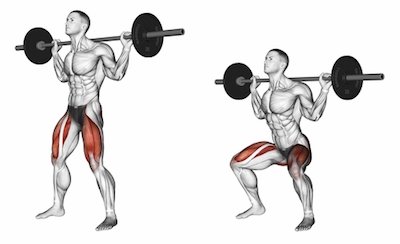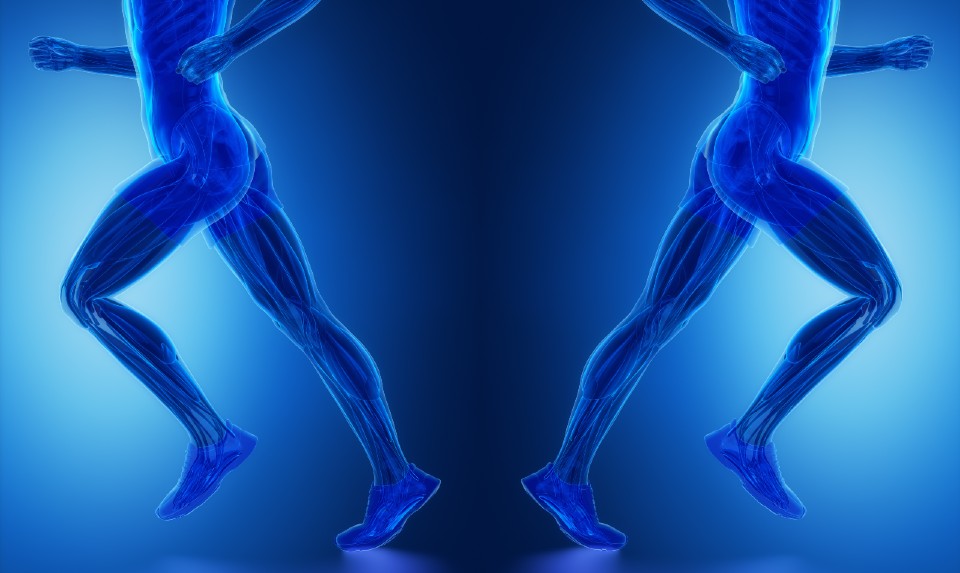
It’s no secret that a strong, toned gluteus maximus (aka your butt muscles) looks great and can improve performance in running, jumping, and sports. But did you know it has numerous other benefits, such as improved hip stability and better posture?
For these reasons, engaging in exercises specifically targeting the glutes should be an integral part of any fitness regimen. Research shows that strengthening the glutes leads to fat loss in the surrounding area while increasing lean muscle mass. Read on to find the best Gluteus Maximus Exercises for working your glutes and getting them to look their best!
What Is The Gluteus Maximus?
The gluteus maximus is the largest muscle in the human body and one of three muscles within the glutes. It comprises a thick, fleshy quadrilateral-shaped mass extending from the top of your pelvic bone to the upper part of your femur (thigh bone). Its primary function is to keep you standing upright by providing the necessary support to maintain a straight posture. However, its importance in helping you develop overall body strength and performance shouldn’t be overlooked.
The gluteus maximus muscle originates from multiple points — including the lateral/posterior surface of the sacrum and coccyx, posterior side of ilium, thoracolumbar fascia, and sacrotuberous ligament — and has two insertion points, the iliotibial tract and gluteal tuberosity of the femur.
Compared to other primates, humans have significantly larger gluteus maximus muscles; this is one of the traits defining us as a species. With greater muscle mass comes increased strength and power. This directly translates into improved running, jumping, and sports performance.
But that’s not all; there are numerous other benefits to having a strong gluteus maximus muscle. Research shows that strengthening the glutes leads to fat loss in the surrounding area while increasing lean muscle mass. It also helps improve hip stability and aids with better posture over time. To make the most of these benefits, engaging in exercises specifically targeting your gluteus maximus muscles should be an integral part of any fitness regimen. A literature review of studies evaluating gluteus Maximus and gluteus medius activation during rehabilitation exercises.
Benefits of Gluteus Maximus Exercises
- Increased Strength and Power – The larger muscle mass of humans’ glutes leads to increased strength and power, directly translating into improved performance with activities such as running, jumping, and sports.
- Fat Loss – Strengthening the glutes leads to fat loss in the surrounding area while increasing lean muscle mass.
- Improved Hip Stability – Stronger gluteus muscles help improve hip stability and prevent lower back pain.
- Better Posture – Exercises that target the gluteus maximus can also help with better posture over time.
Tips for Safely Performing Gluteus Maximus Exercises
Glute training tips are following
- Start slow with light weights and increase gradually as you become stronger.
- Always keep your core engaged while performing gluteus exercises. This will ensure proper form and reduce the risk of injury.
- Focus on squeezing the muscle that you are working on to ensure that it is getting a good workout. Try moving in slow, controlled motions to target the muscle for more challenging exercises.
- Warm up and cool down properly by stretching before and after each workout.
- Aim for at least two days of gluteus maximus exercises per week, but giving your body adequate time to rest between workouts – 48 hours or more is ideal.
Common Mistakes to Avoid When Doing Gluteus Maximus Exercises
- Not activating your glute muscles – When performing any gluteus maximus exercise, you should focus on squeezing the muscle you are working. This will ensure it gets a good workout and prevent other muscle groups from taking over.
- Using incorrect form – It is extremely important to maintain proper form while performing exercises targeting the gluteus Maximus injury., as incorrect form can lead to
- Not giving your body adequate rest – Resting between workouts is essential for muscle recovery and injury prevention. Aim for at least two days of rest between each workout session.
- Overdoing it – If you feel any knee pain or discomfort while exercising, that’s a sign that you’re pushing too hard and should take a break.
- Not switching up your exercises – Doing the same gluteus maximus exercises every time can lead to overuse injuries, so switch it up occasionally and focus on different muscle groups.
Best Exercises For Gluteus Maximus
Maximus is highly recommended to develop the strength and size of your gluteus. If you can access free weights such as dumbbells and barbells, we present the top 8 exercises for enhancing your gluteus maximus muscle and boosting strength. Following these,
1. Bulgarian Split Squats:

Bulgarian split squats are a fantastic exercise for the gluteus Maximus, the quads, and the hamstrings. You’ll need a bench or a sturdy chair to perform this exercise. Stand facing away from the bench with one foot resting on it behind you. Keep your front foot flat on the floor, about hip-width apart. Lower your body until your front knee is bent at a 90-degree angle, keeping your knee directly over your ankle. Repeat this for 10 to 15 reps, then switch legs. One of the key benefits of this exercise is unilateral movement, meaning each leg works independently, promoting balanced muscle development.
2. Glute Bridges:

Best glute exercises bridges are among the most effective exercises for targeting the gluteus maximus. To perform this exercise, lie flat on your back with your knees bent and your feet flat on the floor, about hip-width apart. Press your heels into the floor and lift your hips off the ground by squeezing your glutes, creating a straight line from your knees to your shoulders. Lower your hips back to the ground, and repeat this for 10 to 15 reps.
3. Back Squats:

Back squats are another powerhouse for activating and strengthening exercises the gluteus Maximus and other muscle groups in the legs and core. This compound exercise is a staple in most strength training programs due to its effectiveness and versatility.
To perform a back squat, position a loaded barbell across your upper back, standing with your feet hip-width apart. Engage your core and lower your body by bending your knees and pushing your hips back as if you’re sitting on a chair. Aim to lower until your thighs parallel the ground, keeping your chest upright and your knees tracking over your toes. Push back to the starting position through your heels and repeat for the desired reps.
Back squats’ key benefits are their capacity to promote muscle growth and strength in the gluteus maximus. Exercise positively impacts the lower body’s power output, which benefits athletic performance. Additionally, back squats activate the core muscles, promoting balance and stability.
4. Stiff-legged Deadlifts:

Stiff-legged, also known as Romanian deadlifts, are powerful exercises primarily targeting the gluteus Maximus, hamstrings, and lower back. The exercise is a favorite among fitness enthusiasts and athletes alike due to its effectiveness in building strength and promoting muscle growth in the lower body.
To perform the stiff-legged deadlift, stand upright with a barbell in your hands, palms facing towards you. Your feet should be hip-width apart, and your knees slightly bent. Maintain a flat back and a neutral neck position. Initiate the movement by hinging at your hips, and pushing them back while maintaining a slight bend in your knees. Lower the barbell along the front of your legs until you feel a stretch in your hamstrings. The barbell should almost touch your feet at the bottom of the movement. Squeeze your glutes and thrust your hips forward to return to the starting position. The focus should be on moving the hips, not the lower back.
5. Weighted Step-Ups:

Weighted step-ups are phenomenal for targeting the gluteus maximus. They help sculpt a robust lower body, boost muscular endurance, and enhance overall leg strength. This lower body movement is excellent for building muscular strength and improving balance and coordination, essential in functional fitness.
You will need a sturdy box or bench and a pair of dumbbells to perform weighted step-ups. Start by standing upright, facing the bench with a dumbbell in each hand. Place your right foot on the bench with your chest up and shoulders back. Use your right leg to push your body upwards until both legs are straight. After a brief pause, lower yourself and repeat the movement with your left leg.
The key here is to ensure the working leg (stepping up) does most of the work. The trail leg (the one on the ground) should have minimal involvement in the movement. This ensures maximum activation of the gluteus maximus. It’s also critical to control your movements, particularly when returning to the starting position, to avoid any potential injuries.
6. Hip Thrusts:

Hip thrusts are a powerful exercise extensively used in strength and conditioning programs for their remarkable ability to target the gluteus Maximus largest and strongest muscle in the human body. You’ll need a bench or a sturdy platform to perform a hip thrust. Begin seated on the ground with your back against the bench; knees bent, and feet flat on the floor. A barbell positioned across your hips will add resistance to the exercise.
Ensure you have a pad or towel to protect your hips from the pressure of the barbell. Hold the bar with your hands to keep it stable, then push through your heels to lift your hips until your body forms a straight line from your shoulders to your knees. Squeeze your glutes at the movement’s top before lowering your hips back. Aim to complete 10 to 15 reps.
Hip thrusts offer manifold benefits. They are a fantastic tool for building gluteus maximus strength and size. They allow for heavy loading, which can stimulate significant muscle hypertrophy. Additionally, these exercises can enhance athletic performance, aiding in sports that require a powerful hip extension, such as sprinting or jumping.
7. Sumo Deadlifts:

Sumo Deadlifts are an effective variation of the traditional deadlift, primarily focusing on the gluteus Maximus with other lower body muscles such as the hamstrings, quadriceps, and adductors. The sumo deadlift differs from the conventional deadlift in its wider stance, which allows for a shorter range of motion, potentially enabling the lifter to pull heavier weights.
To perform a sumo deadlift, you must position yourself behind a loaded barbell, standing with your feet wider than shoulder-width apart. Your toes should be pointed slightly outwards, in line with your knees. Bend at your hips and knees to lower your body and grasp the barbell with a double overhand grip. Your hands should be shoulder-width apart, inside your knees. Brace your core, keep your back flat and chest up. Now, initiate the lift by driving through your heels and extending your hips and knees. Stand up tall at the top of the lift, squeezing your glutes. Lower the bar back to the ground by reversing the movement, maintaining control.
8. Kneeling Squats:

Kneeling squats are a lesser-known but highly effective exercise for isolating the gluteus maximus. This targeted exercise engages the glutes more directly by reducing the involvement of the quadriceps and hamstrings, which is common in other lower-body exercises.
Set up a barbell on a squat rack at about waist height to perform a kneeling squat. For comfort, kneel on a soft surface, such as an exercise mat. Your knees should be hip-width apart, and your toes should be tucked underneath you. Stand up just enough to un-rack the barbell, then hold it across your upper back just like you would during a traditional squat. Hinge at your hips to lower your buttocks towards your heels, keeping your chest and back straight. Once you’ve reached the bottom, push through your knees and hips to return to the starting position.
Kneeling squats are unique in isolating the gluteus maximus due to the limited range of motion and elimination of the ‘push’ phase. We usually engage in exercises like traditional squats or deadlifts. They can be an excellent addition to a glute-focused workout regimen, particularly for individuals seeking to enhance the strength, size, and shape of their gluteus maximus. However, as with any exercise, proper form and technique are essential to reap the full benefits and prevent injury.
Best At Home Gluteus Maximus Exercises:
Exercising at home without weights or preferring bodyweight exercises doesn’t mean you can’t effectively target your gluteus Maximus as long as you employ the right strategies. Progressive overload principles, such as increasing workout volume, extending time under tension, and reducing rest periods, are still crucial even for bodyweight training. For instance, you could tailor your rest period to 30 seconds instead of 60-90 seconds, typically recommended for hypertrophy with free weights. You can also creatively add resistance to your workouts. Consider filling a backpack with books, using gallons of water, or even a rock from your yard. It might be a bit challenging to precisely increase the weight, but if you have a scale, it’s feasible.
The bottom line is the absence of traditional free weights doesn’t mean you can’t sculpt an impressive gluteus maximus. Selective focus on the right exercises is essential, just as it is with gym workouts. The upcoming exercises are excellent for developing your gluteus maximus. Remember the importance of a full range of motion, maximizing tension in your gluteus minimus, and ensuring adequate time under tension (ideally around 45-60 seconds for bodyweight exercises, but at least 30 seconds).
1) Single Leg Glute Bridges:

Single-leg glute bridges are an excellent at-home exercise for developing your gluteus maximus. Begin by lying on your back with your knees bent and feet flat on the ground about hip distance apart. Lift one foot slightly off the ground, then push through your opposite heel to raise your hips until they form a straight line from shoulder to knee. Squeeze your glutes at the top of the movement. Lower your hips back to the start position before performing another rep on the same side. Aim for 8-12 reps on each leg for 2-3 sets total.
2) Hip Thrusts:

Hip thrusts are a great bodyweight exercise for developing the gluteus maximus. Start by sitting on the ground with your upper back against a couch or wall and both feet flat on the floor. Your knees should be bent at 90 degrees. Raise your hips until they form a straight line from shoulder to knee, squeezing your glutes at the movement’s top. Lower your hips back down to the start position before performing another rep. Aim for 8-12 reps for 2-3 sets total.
3) Curtsy Lunges:

Curtsy lunges are a great way to target the glutes without weights. Begin by standing with your feet hip-width apart. Step one foot behind and across the other in a curtsy position, then bend both knees to lower into a lunge. Your front knee should be bent 90 degrees, and your back knee should almost touch the ground. Push off your front heel to return to the starting position. Aim for 8-12 reps on each side for 2-3 sets total. Keep your chest up and back straight throughout the movement, engaging your core and weak glutes.
4) Sprints:

Sprints are an incredible and often overlooked exercise for developing the gluteus maximus. To perform sprints, run steadily until you reach the desired distance. Once you reach your destination point, explosively accelerate as fast as possible for the final stretch, ensuring your hips are pushed back and glutes engaged. Aim to complete 8-12 sprints of 30-60 yards each for 2-3 sets total. Adding running hills can help to emphasize glute activation even further.
5) Step Ups:

Step-ups are a relatively simple exercise that can be modified to target the gluteus maximus. Begin by standing in front of a sturdy box, bench, or other elevated surface with one foot flat on top and your other leg straight behind you. Push through the heel of your lead foot to raise your body off the ground and onto the elevated surface. Try to focus on driving your knee up towards your chest at the top of the movement and controlling your descent back down. Aim for 8-12 reps on each leg for 2-3 sets total. You can place your hands on a wall or railing for support to make it easier.
FAQs
How often should I be doing these exercises?
To maximize results, aim to complete 2-3 sets of 8-12 reps for each exercise 2-3 times weekly. However, always listen to your body and adjust the frequency/volume of your workouts accordingly.
What are some good variations of glute bridges?
Single Glute Bridge, Hip Thrust, and Curtsy Lunges are excellent variations of the traditional glute bridge exercise that target the glutes without requiring any weights. You can add extra resistance by using a backpack filled with books or a rock from your yard for an added challenge.
What other activities can help target my glutes?
Besides the exercises mentioned above, running and sprinting are excellent activities for targeting your glutes. You can also incorporate walking lunges or jump squats into your HIIT workouts for an added challenge.
What should I focus on when doing each exercise?
Focusing on proper form and full range of motion is important when performing the above exercises. Additionally, aim to maximize tension in the glutes by keeping your chest up and back straight throughout the movement while engaging your core and glutes.
Conclusion
Strengthening your glutes can offer numerous benefits, such as improved posture, increased power and speed, and enhanced performance in activities like running and jumping. Incorporating the exercises mentioned above into your routine is a great way to target the gluteus maximus without equipment or weights. Remember to focus on proper form, full range of motion, maximizing tension in the gluteus Maximus, and adequate time under tension (ideally around 45-60 seconds for bodyweight exercises).



